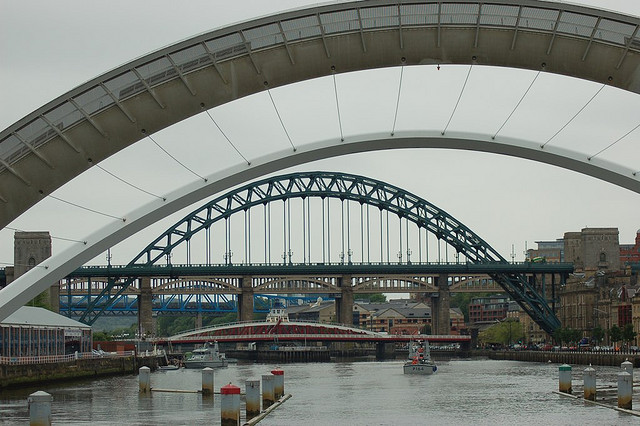Only an approach founded on rights and obligations can allow for effective and legitimate public infrastructure provision
On Monday 23 March 2015, Dialogue by Design and the UCL Transport Institute co-hosted a seminar, We Need to Talk about Infrastructure, chaired by Jim Steer of Steer Davies Gleave. We posed a simple question: when Government plans to invest £375 billion in infrastructure projects up to 2020, how can this be done with local communities, rather than against them? Elena de Besi argues that only an approach to infrastructure that is founded on the rights and obligations we have as members of a society would allow for the provision of infrastructure that is effective, timely and built on public legitimacy.

Credit: Jeff, CC BY 2.0
We expect infrastructure to exist as a citizen’s right: infrastructure that is not just provided for the sake and benefit of a limited number, but that we can all use and access safely, that is limited in its environmental impacts and provides a high level of service to citizens. But this expectation does not seem to create symmetric obligations for citizens, if not to embrace, then at least to accept the disruption that attends its construction.
Is there an approach to infrastructure provision that could help get past the lack of public acceptance? And, if so, what are the consequences in terms of planning and engagement?
In recent years decision makers and developers in the United Kingdom have learned how a lack of public consensus can prevent the efficient and timely delivery of infrastructure that addresses pressing challenges such as population growth and climate change. The acronym ‘BANANA’ (Build Absolutely Nothing Anywhere Near Anything) has often been used to characterise the vehement local opposition that accompanies many major infrastructure schemes. Benefits from major infrastructure projects are often distant prospects and are shared with many others. This can make them difficult to grasp fully, whilst their construction and operation cause very visible and immediate economic, social and environmental negative impacts. Moreover, the massive costs of these projects are usually – if only in part – paid for by the public. The overall decision-making and funding processes are often perceived as lacking openness and transparency, notwithstanding the requirement for public consultation for Nationally Significant Infrastructure Projects (NSIP) under the Planning Act 2008.
Advocates must recognise that infrastructure always involves winners and losers; each with their own legitimate yet potentially conflicting interests that must be respected. Whilst these ‘wicked problems’ by definition have no easy solution, participants at our event agreed strongly on two points. For starters, understanding why something is actually done is a necessary though not sufficient step towards its acceptance. Second, a much better job needs be done to convey to the public why an infrastructure scheme is needed, and why that location, timescale and technology are the most appropriate in a given case. This is especially true for major infrastructure schemes, which will likely affect certain groups that will neither make any use of nor receive any indirect benefits from those schemes.
In such cases, Professor Brian Collins argued that leveraging the concept of ‘shared infrastructure’ might contribute to making the need case, increasing the legitimacy of a scheme and reducing the likelihood of widespread opposition. Looking at infrastructure as ‘shared’ means acknowledging the social value we get from it. In fact, infrastructure shapes the economic, social, cultural and political systems in which human activities take place, allowing us to participate in these systems as individuals and as members of a society. This value is, however, often taken for granted. Most of the time we tend to forget that, whilst we might be negatively affected by the construction of a road 50 metres from our home, we are almost certainly making use of the electricity carried along unsightly pylons whose appearance disturbs communities distant from us. The key issue here is getting the message across that there are both negative impacts and shared benefits across different types of infrastructure, and that these are linked to one another and exist in a system.
Another key consideration here is that these rights and obligations should be shared fairly. It is certainly true that some communities or social groups are more adversely affected than others by certain types of development. Whilst distributional impacts should be a key part of analysing shared infrastructure, this lies outside the scope of this paper. Ultimately, the shared nature of infrastructure relates to the fundamental rights and obligations that as individuals we have in a society: the right to infrastructure that is functional, safe, and respectful of the environment; but also an obligation to pay a price in order to enjoy and make use of it. So, if people understood the shared nature of infrastructure, there is a real chance they would oppose it less. We argue, though, that the opportunity to leverage the rights and obligations of the public in relation to shared infrastructure relies on two interdependent conditions. The first is having a strategic planning system, and the second is creating a space for meaningful public engagement on the need case.
More and more is being said on the need to have a strategic and cross-sector approach to national infrastructure planning in the UK, as opposed to a piece-meal, reactive and short-sighted one. Participants at our event emphasised that this lack of strategy means there is no transparency about the criteria by which the need for a scheme under discussion is to be judged. This leads to much of the controversy and lack of support that prevent long-term investment in infrastructure.
Whilst public consultation on infrastructure is intended to build the basis for legitimacy and thus reduce controversy, the way it is often carried out has significant limitations. Many public consultations take place at the very end of the development process, only allowing the public to express its views on how a scheme should look, and not if it is actually needed. There is no deliberative process in place at present where genuine negotiation concerning principles can take place.
Effective public engagement needs to convey what specific problem a project is intended to address, as well as the inter and intra-sector linkages with other ‘shared’ infrastructure. At the same time, it needs to allow the public to contribute meaningfully on the question of need in order to build national consensus on which priorities are to be addressed, how, when and where. It should then be much easier to justify the case for any individual scheme as, ideally, it would sit coherently within a vision of the nation’s overall needs which the public has helped to develop.
The current decision-making and consultation process has understandably led to a widespread and deep-rooted lack of trust that has eroded belief in the shared nature of infrastructure. When people feel excluded from decision making, they become more distant, disengaged and suspicious of the real motives behind a scheme being proposed. A strategic infrastructure plan in which each scheme makes a defined contribution to an agreed over-arching objective and provides shared value is likely to build trust in the long term. Engaging both early in the process and specifically on the question of need will equally help to restore public trust, as citizens would be more likely to perceive that decisions on questions of principle and locations are not simply being imposed on them.
So, having a strategic planning process and a space for meaningful public engagement are mutually reinforcing and necessary for the public to adopt the concept of infrastructure as shared. If the public is not presented with the need case and provided with a meaningful opportunity to debate it, we cannot expect them to accept their obligations. The same will be the case if there is no clear purpose or long-term vision behind the schemes that are brought forward. Putting these conditions in place is not an easy task. But a persistent absence of public acceptance might in time produce a planning system that is unable to respond to the future needs of our society. In the long run, only an approach that is founded on the rights and obligations we have as members of a society would allow for the provision of infrastructure that is effective, timely and built on public legitimacy.
—
This chapter is an extract from the Infrastructure and the Citizen policy paper, which can be downloaded for free from the OPM website.
You may also be interested in two other posts from this series: ‘The potential for public dialogue and deliberation in the development of national infrastructure policy‘ by Ian Thomson, and ‘‘Depoliticising infrastructure’: can a strategic approach enhance public engagement?‘ by Morgan Wild.
It represents the views of the author and not those of Democratic Audit UK or the LSE. Please read our comments policy before posting.
—
 Elena de Besi is a Project Coordinator at Dialogue by Design (OPM Group). Find out more about her here.
Elena de Besi is a Project Coordinator at Dialogue by Design (OPM Group). Find out more about her here.





 Democratic Audit's core funding is provided by the Joseph Rowntree Charitable Trust. Additional funding is provided by the London School of Economics.
Democratic Audit's core funding is provided by the Joseph Rowntree Charitable Trust. Additional funding is provided by the London School of Economics.
[…] in the development of national infrastructure policy‘ by Ian Thomson and ‘Only an approach founded on rights and obligations can allow for effective and legitimate public inf…‘ by Elena de […]
Current decision-making and consultation process has understandably led to a widespread and deep-rooted lack of trust https://t.co/kv1FmrDZmJ
Would viewing major #infrastructure as ‘shared’ – phrase coined by Prof Brian Collins @UCLSTEaPP – reduce opposition? https://t.co/aHALYLOwhg
Only an approach founded on rights and obligations can allow for effective and legitimate infrastructure provision https://t.co/O48KQ2FXnB
[…] Only an approach founded on rights and obligations can allow for effective and … We expect infrastructure to exist as a citizen's right: infrastructure that is not just provided for the sake and benefit of a limited number, but that we can all use and access safely, that is limited in its environmental impacts and provides a high … Read more on Democratic Audit UK […]
Only an approach founded on rights and obligations can allow for effective and legitimate public infrastructure pr… https://t.co/nbtZwiKvuH
Catch the final instalment of our engagement and infrastructure series on @democraticaudit today: https://t.co/roHMFzf6C8 @DbyDteam
Our blog for @democraticaudit:”only #infrastructure provision founded on rights & obligations can achieve legitimacy” https://t.co/Ios9hGr22Y
Shared infrastructure: the way past the failure of public acceptance? https://t.co/ewa4aNvyy5
Only an approach founded on rights and obligations can allow for effective and legitimate public infrastructur… https://t.co/znl0xcicwO
Only an approach founded on rights and obligations can build infrastructure that is effective & has public legitimacy https://t.co/rtVyHcyek7
Only an approach founded on rights and obligations can allow for the provision of… https://t.co/joZyZQIsVG https://t.co/7AfXWyXLBI